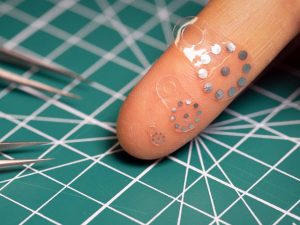The question that inspired the technique was: how do we spot leaks from the gut after gastric surgery?
Neither ultrasound, CT or MRI scanning could be used to remotely determine local chemistry around the internal wound, according to Northwestern University, which teamed up with the Washington University School of Medicine in St. Louis to find an answer: fingerprint-sized stickers that can be left inside the patient on which a ring of circular metallic discs are deposited.
“Because the acoustic properties of the metal disks are much different than those of the surrounding tissue, they provide very strong contrast in ultrasound images,” said Northwestern bio-electronics specialist Professor John Rogers – who has previously guided the development of implantable temporary pacemakers, nerve stimulators and pain ameliorateors.
The sticker substrate is chosen to react to the chemistry of interest: in the proof-of-concept, it was a hydrogel which swells under the influence of acid, moving the dots apart by an amount noticeable during an ultrasound scan.
Substrates between 4 and 12mm were been made, with dots 1mm across in the 7mm version, for example.
“Rogers realised that it might be difficult for radiologists to assess the images manually,” said Northwestern. “To overcome this challenge, his team also developed software that can automatically analyse the images to detect with high accuracy any relative movement of the disks.”
The idea is for the sticker to be stuck or sewn to organs towards the end of surgery, or rolled up and pushed out into the right place through a hollow tube from outside the body.
Like Rogers’ other temporary devices, the sticker’s materials are chosen so that the body can absorb them entirely.
“We like to monitor patients for complications for about 30 days,” said Washington University gastrointestinal surgeon Chet Hammill. “Having a device that lasts a month and then disappears sounded ideal.”
Similar tags are being explored that change in response to internal bleeding or temperature.
Science has published the work as ‘Bioresorbable shape-adaptive structures for ultrasonic monitoring of deep-tissue homeostasis‘.

